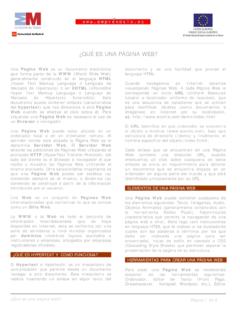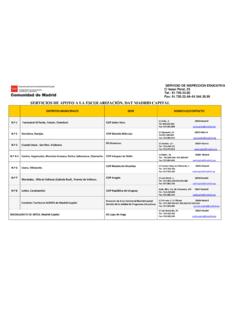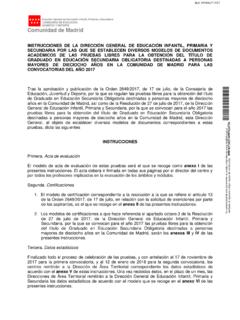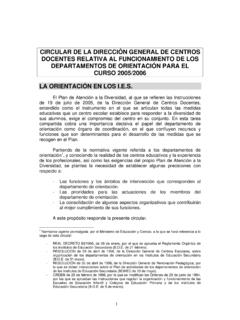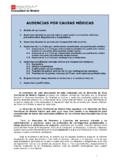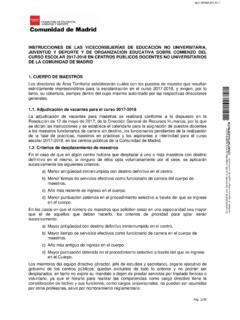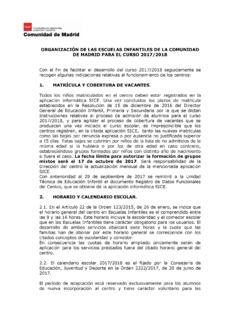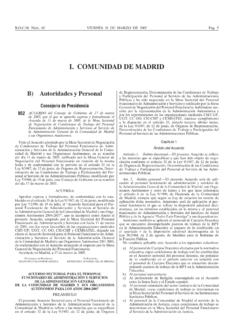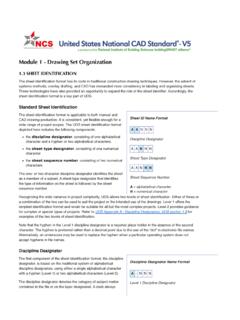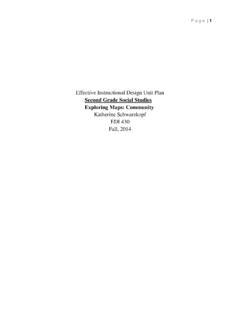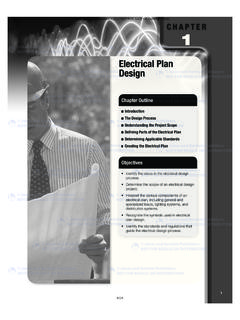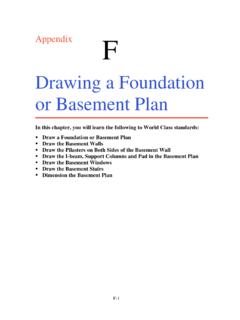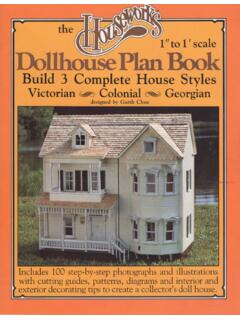Transcription of BUSINESS PLAN - Comunidad de Madrid
1 BUSINESS What is a BUSINESS plan ? is a BUSINESS plan ? 2. 2. WhatWhatis the is the purposepurposeof a BUSINESS plan ?of a BUSINESS plan ?3. 3. WhyWhyprepare a BUSINESS plan ? prepare a BUSINESS plan ? 4. 4. ContentContentof a BUSINESS Planof a BUSINESS Plan5. 5. FinancialFinancialPlan plan 6. 6. BenefitsBenefitsto be to be derivedderivedfromfroma BUSINESS Plana BUSINESS Plan1. What is a BUSINESS plan ?1. What is a BUSINESS plan ?9A BUSINESS plan is a document in which a BUSINESS opportunity, or a BUSINESS already under way, is identified, described and analyzed, examining its technical, economic and financial feasibility. The plan develops all of the procedures and strategies necessary in order to convert the BUSINESS opportunity into an actual BUSINESS project.
2 9It is an indispensable tool in order to start up a BUSINESS project, independently of the size of the project and/or of the amount of BUSINESS experience of the provides an answer to simple questions about a new BUSINESS or a BUSINESS already under way:2. What is the purpose of a BUSINESS plan ? 2. What is the purpose of a BUSINESS plan ? 9 The purpose of a BUSINESS plan is to identify, describe and analyze a BUSINESS opportunity and/or a BUSINESS already under way, examining its technical, economic and financial , it should serve as a BUSINESS card for introducing the BUSINESS to others: banks, investors, institutions, public bodies or any other agent involved, when it comes time to seek cooperation or financial support of any BUSINESS plan has a dual function: Management Tool.
3 Planning Tool. Management Tool: Provides economic/financial projections. Enhances the monitoring and control of the BUSINESS by following up the results obtained and analyzing management indicators. Introduces an analysis of the supply and demand. Reflects the commercial strategy and the marketing policy. Identifies the guidelines for the management of human resources. Analyzes the key factors of success and the risks of a Tool:The company assumes and takes responsibility for the definition of its objectives: With results-oriented actions. Strict fulfillment of its economic commitments. Orients decision-making processes: Provides qualitative and quantitative information. Planning conforms to a homogeneous Why prepare a BUSINESS plan ?
4 3. Why prepare a BUSINESS plan ?4. Content of a BUSINESS Plan4. Content of a BUSINESS PlanThe development of a BUSINESS plan consists of the following elements, which provide answers to the main questions that can be raised by third parties:ANALYSIS OF THE PRESENT SITUATION What is the sector like? What is the present situation of the sector and the future outlook? Who are the competition in the sector in which the company participates and what is the degree of rivalry among competitors? Who are the potential competitors? What are the main factors that determine the success or failure of a competitor in the sector? In what way is our BUSINESS different from the BUSINESS of our competition? Identify weaknesses, threats, strengths and opportunities of the BUSINESS .
5 Is there a target market for this BUSINESS ? BUSINESS plan OBJECTIVES What are the reasons for investing in this BUSINESS ? What does my BUSINESS consist of? What are the goods or services that I am going to offer? What strategy am I going to follow in order to maintain a competitive advantage over time; specialization, differentiation or competition in costs? What areas or processes are critical for the development of the BUSINESS ? What areas are supports for the critical processes of the BUSINESS ? What are my perspectives on the evolution of the BUSINESS ?STRATEGIC plan What is the mission of my company? How are the strategic lines of my project going to unfold as long-term objectives? Have specific action plans been defined for achieving the long-term objectives?
6 Have resources been allocated to such plans? How is my marketing policy structured? Have I considered the price, location, product, promotional aspects? How many employees comprise my staff? And what are my personnel management policies? Have I planned for the financial needs that could arise in the long term? plan The purpose is to analyze the profitability and economic feasibility of the BUSINESS project. This analysis is the quantification of the strategy defined by the entrepreneur and will enable him or her to analyze the economic impact of the decision making. A full analysis includes a projection for the time horizon considered in the BUSINESS plan . Income and Expenditure Projections Investment Budget and Depreciation Schedule Profit and Loss Account Borrowing Requirements Balance Sheet Cash Flow Net Present ValueINCOME PROJECTIONINCOME PROJECTION9 The step prior to drawing up the Profit and Loss Account is to project the income and expenditure on the time horizon considered in the BUSINESS income projection is made for each product line or BUSINESS line, if such lines exist.
7 For each item of income, the most appropriate variable for an accurate projection is taken: sales volume, growth of the potential market, market share, The revenues will be imputed to the relevant product or BUSINESS PROJECTIONEXPENDITURE PROJECTION9 For the projection of expenses, an analysis is made of the items that make up each expenditure account used, estimating what their future trend is likely to be, and finally moving on to their quantification, both economic as well as in the expense unit itself (number of people, computers, etc.).For example, in order to project the financing charges, we must take the total amount of the debt owed to third parties and apply to it the interest rate estimated for the financial years being BUDGETINVESTMENT BUDGET9 The expenditure is the flow of resources that is consumed in obtaining the product or service supplied or provided by the company.
8 In contrast to investment, it is the application of financial resources to be used to increase the fixed or financial assets, in exchange for the expectation of obtaining future : machinery, equipment, public works, bonds, certificates, securities, SCHEDULEDEPRECIATION SCHEDULE9 Depreciation is the depreciation or loss in value that investments in fixed assets undergo over time (equipment, machinery, etc.). 9In order to offset the depreciation undergone by the property elements, the entrepreneur must create a depreciation fund. This fund grows each year in an amount equal to the loss in value undergone by the assets, in such a way that by the end of the economic life of the depreciable element, the entrepreneur will be able to replace that element by using the money accrued in the depreciation fund.
9 This item in the accounts does not signify an outlay of cash, but rather is an expenditure item that involves reducing the profit for the are different fixed asset depreciation methods, in order to calculate the annual allotment for depreciation of each kind of asset: straight-line, accrual, straight-line depreciation method consists of keeping the depreciation allotments constant throughout the useful life of the element. A part of the depreciation value is assigned to each example for calculating the depreciation increments:Tangible fixed assets Year 0 / Period in years of depreciation of tangible fixed assetsPROFIT AND LOSS ACCOUNTPROFIT AND LOSS ACCOUNT9 The basis for the economic analysis is found in the analysis of the Profit and Loss Account.
10 This analysis enables us to assess issues such as: Performance of the turnover. Trends in the gross margin. Trends in overhead and financing the financial plan , the Profit and Loss Account is formed with the income projection, the expenditure projection and the depreciation Profit and Loss Account will also be broken down into the product or BUSINESS lines, if these exist, both for the current year as well as for the future years that are being structure of the Profit and Loss Account is as follows:BALANCE SHEETBALANCE SHEET9 The Balance Sheet reflects the company s net worth, which is made up by the property, rights, debts and capital which the company has at any given time. 9An analysis of a company s balance sheet makes it possible to assess aspects such as: its liquidity situation or payment capacity, indebtedness (quantity and quality), projection should be made of the balance sheet estimated for subsequent financial years, considering aspects such as the financing of the company in the short term (period less than one year) and in the long term (more than one year).
